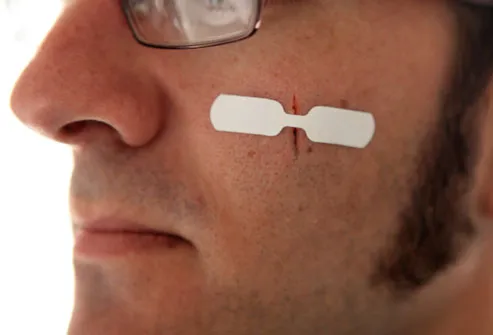 |
| OWIE! |
Having recently purchased a first aide kit for my home I'd like to discuss the proper way to clean and dress a minor wound. As my mom would say: seriouser than a sliver, smaller than surgery.
 |
| Arm Laceration that requires stitches |
1) Cleanliness and safety are key. Unless this is your wound make sure to take steps to protect yourself from blood-born pathogens. Wash your hands and use latex gloves.
2) Assess the wound. A little bleeding is okay, because it helps flush dirt and germs out of the wound. However, if the blood is bright, bright red, or is squirting out these are signs for more serious medical attention (one I will address at a later date). Also be concerned if the wound is deeper than an inch in the chest, neck, back, pelvic or the areas above the elbow or above the knee. To stop the bleeding if it is excessive (head wounds tend to bleed a lot since there are a lot of corposles in the scalp) hold a piece of sterile gauze or clean unfluffy towel to the wound and apply steady, constant pressure to the wound. DO NOT REMOVE GAUZE UNTIL BLEEDING HAS STOPPED. If you take it off too soon you'll rip out the clot forming beneath the wound, effectively making you start over from scratch. Elevating the wound will also help slow the bleeding.
 |
| Use running water to cleans wounds |
3) Clean the wound. Flush the wound with clean running water. Make sure to use
running water as this is a lot more effective at removing contaminates and dirt from a wound than dabbing or wiping would. Use tweezers to remove debris from the wound. Wash the area around the wound with soap (don't worry if the soap gets into the wound, though it may sting it won't cause lasting harm). Rinse again with running water. DO NOT USE AN ALCOHOLIC OR IODINE SWAB ON AN OPEN WOUND. Go back and read that sentence again. Alcohol and Iodine are for cleaning solid skin before an injection, not cleaning an owie. Use HYDROGEN PEROXIDE to clean wounds. Pour a little (not straight from the bottle as the wound may come in contact with the bottle lip, thus contaminating it) onto the site and allow it to fizz. The fizzing is the Peroxide coming in contact with germs and other contaminates, which is good. This also helps to let you know if the wound is infected, as if the peroxide fizzes over a healing wound, that wound may be infected. Soap and water however work just fine if peroxide is not available.
 |
| Butterfly bandages close small cuts well |
4) Dress the wound. Bandage the wound but only if it is likely to come in contact with dirt. Butterfly bandages can be used to hold a laceration together if needed. Otherwise it is often best to let the wound heal in the open air since bandages may trap moisture near the wound, thus better enabling the growth of bacteria. If it is large enough or serious enough of a wound to require dressing, change the dressings often and make sure the wound is clean before reapplying the dressing. Use antiseptic spray or ointment with each dressing change until the wound closes. Keep the wound as dry as possible.




No comments:
Post a Comment